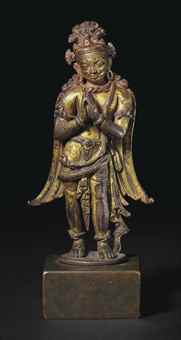
11th-12th century, Nepal, Kathmandu Valley, Buddha sheltered by serpent king Muchalinda, schist, 44,2 cm, at the Art Institute of Chicago (USA).
The historical buddha is seated with his hands in the gesture of meditation under the protective hood of Muchalinda, king of the nagas, usually depicted with seven cobra heads.
Five playful characters adorn this handle formed by a long serpent. The middle three have a naga hood, arms and legs, the first one from the bottom has a naga/cobra hood and lower body, the others have a naga hood and legs.
This elephant supports a winged lion (viyala), a boy with a semi-divine appearance riding a horse-like animal with a scaly body (sharabha) and holding up a triple gem in his left hand. The top is decorated with a makara. (See the page on animals and mythical creatures at the top of the left-hand column of this blog).

16th century, Nepal, nagaraja Kalya with his wife and young Krishna, copper alloy, 14 cm, private collection, photo on Koller
Although these characters belong to the Hindu pantheon, naga kings are also part of Himalayan Buddhist art and this rare (Hindu) sculpture of an endearing couple illustrates their half human and half serpentine aspect. The king wears a hood made of three cobra heads, his wife’s naga hood is made of one cobra head only. They have an urna on their forehead and wear a crown and princely jewellery. Crouching on their tails, coiled and entwined, appears a young Krishna.

Her hands are affectionately placed on her husband’s chest and back. He holds a serpentine sceptre.

14th century, Nepal, Viyala, gilt copper alloy repoussé and traces of pigment, labelled ‘vyala’ on HAR , at the Rubin Museum of Art in New York (USA).
Also part of a torana (back plate of a buddha’s throne), this fragment shows a sharabha (or a viyala) standing on its hind legs among scrolling vegetation, a boy with a rincely appearance seated on its back, making the fear-allaying gesture with his right hand and holding a solar wheel in the other.

15th century, Nepal or Tibet, prabhamandala fragment depicting (a) garuda and naga (kings) gilt bronze, private collection, photo on Sotheby’s
Often placed at the top of backplates in Nepal and Tibet, the garuda is the enemy of the nagas. He crouches with his arms extended to hold a long snake (broken here) in his beak. The naga kings below him grab him by the talons with one hand and hold a solar wheel in the other (cakra).

Circa 15th century, Tibet or Nepal, gilt copper repoussé, private collection, photo by Sotheby’s.
For comparison, this torana top, possibly from Tibet, includes a central arch with five buddhas around it, a small bodhisattva and a large makara on each side.

16th-17th century, Nepal, torana fragment, gilt copper repoussé, private collection, photo on Woolley & Wallis
Kirtimukha, of Hindu origin, is particularly popular in Nepal and Tibet. He often has vegetation coming out of his mouth (originally he emerged from a cloudscape) and is a recurrent feature in Malla art, especially on the central panel of crowns and at the top of back plates. He is seen here devouring nagas and accompanied by two makaras.
































